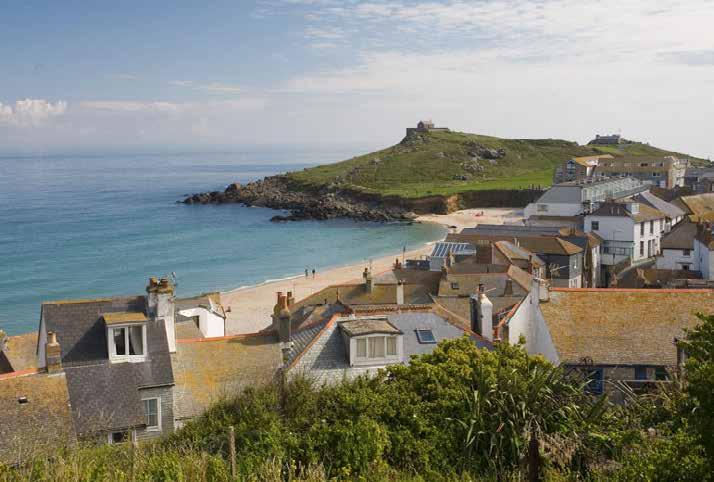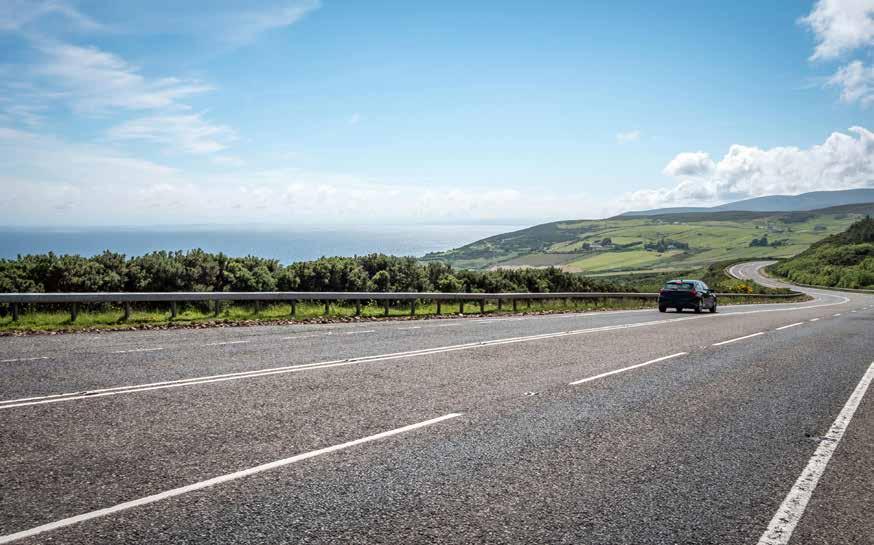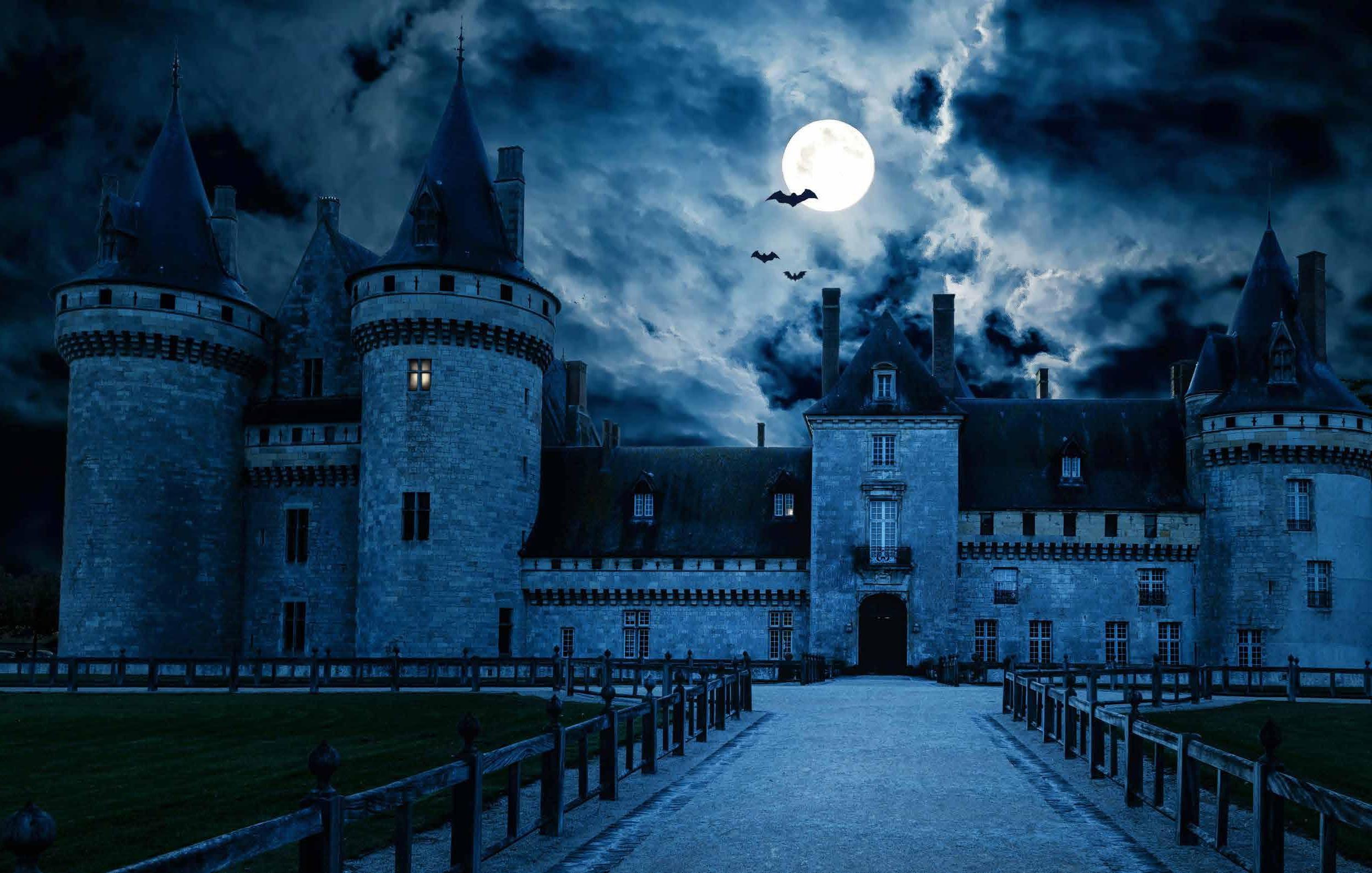
26 minute read
Glamis Castle, Scotland
5. Warkworth Castle, Northumbria
You might encounter yet another Grey Lady who continues to haunt the towers of Warkworth Castle, near Morpeth, on the coast just north of Newcastle. It’s unclear just when the Grey Lady started her eerie wanderings but Warkworth has a long history stretching right back to the year 1139 when stone buildings first appeared on the present site. Visitors to the castle report a “chilling aura” that affects children and dogs.
6. Dunster Castle, Somerset
Once an ancient Norman fortress, Dunster Castle in Somerset these days is home to innumerable sightings of ghosts, inexplicable happenings, sinister and peculiar sensations that might be felt by you – and some that seem only to be felt by dogs! A ‘green man’, for example, continues to haunt what was once the stable block. National Trust staff at the castle have been terrified when confronted by a disembodied human foot appearing from nowhere (and disappearing just as promptly) or hearing loud voices and heavy footsteps within the empty castle at night. The scariest part of the castle, however – and the one your dog may refuse to enter – is the deep, dark dungeon where the skeletons of a whole group of prisoners, including one estimated to have stood seven feet tall, were found all manacled together in one hideous pile.
7. Portchester Castle, Portsmouth
A black monk, a ghostly apparition on horseback and numerous other ghosts continue to haunt the remains of Portchester Castle in Portsmouth. Within the grounds of the castle, there is still a Norman church and, within its graveyard, evidence of satanic witchcraft rituals have been discovered, according to the Ghost Story website. One of the saddest – though harmless – ghosts to continue to prowl the castle is the White Lady. She is believed to be Charlotte White who was visiting Portchester Castle during Victorian times when her baby fell into the moat that surrounds it. Charlotte drowned in the attempt and can sometimes be seen in her grief about to throw herself from the top of the Keep.
8. Blickling Hall, Norfolk
It may not be a castle, but it’s a grand and historic country estate, haunted by a former Queen of England no less. That Queen is Anne Boleyn who was beheaded by King Henry VIII (when she failed to give him a male heir) but was born in the manor house that stood on the site of what is now Blickling Hall. Anne’s headless ghost can be seen returning to the house on the 19th of May every year – the anniversary of her execution. She appears at night, with her head in her lap, in a coach driven by a headless horseman. As the coach approaches the front doors of the Hall, it disappears into the night. Another ghost said to commemorate the anniversary of his death at Blickling Hall is that of Sir John Falstofe – on whom playwright William Shakespeare based his character Falstaff.
We hope you have enjoyed this round up of some the UK’s most haunted castles. Are you brave enough to venture in to one?
THE GREAT BRITISH PICNIC MENU
We all love a good picnic and you don’t just have to one in the Summer, Autumn is a great time too – just wrap up warm!
Get creative in the kitchen using the recipes, then dig out that picnic blanket, pack some hot chocolate and have a fun, British-themed dining experience to remember. Words and images courtesy of VisitBritain.com.


Scotch Eggs
There are a number of theories as to the origin of the Scotch egg, from its creation at London’s luxury department store Fortnum & Mason in the 18th century, to more humble beginnings in the coastal city of Whitby in Yorkshire in the late 19th century. Wherever these savoury snacks hail from, one thing is certain: this British classic makes for an utterly sumptuous picnic treat… Made by wrapping breaded meat around a boiled egg, Scotch eggs can be enjoyed hot, cold or with a touch of mustard.
Ingredients (makes 6):
6 eggs (large if possible) 2 beaten eggs 20g (7/8 cup) thyme 20g (7/8 cup) parsley 1 tablespoon Worcestershire sauce 300g (1 ½ cups) minced meat 400g (1 ¾ cups) skinned sausages Pinch of salt and ground pepper 1 teaspoon English mustard powder Flour ( for coating the eggs) 100g (1 cup) dried breadcrumbs Oil for cooking
Preparation:
To prevent cracking, carefully pierce the eggs with a needle and place in a saucepan to boil for five minutes. Once cooked, run under a cold tap and gently peel from their shells.
Next, mix the sausage meat with the minced meat in a large bowl, along with the Worcestershire sauce, mustard powder, and the herbs. Season with salt and pepper and mix until combined. Spread the contents of the bowl evenly on baking paper and cut into six squares. Coat each of the eggs with flour and then place one on each of the meat sections, wrapping around the egg entirely. The encased eggs then need to be coated with the flour, followed by the beaten egg and finally the breadcrumbs. Pour oil into a high-edged frying pan until five centimetres deep, and heat. Place each of the eggs into the hot oil using a utensil and being mindful of splashes/spitting. Rotate onto each side once golden, until completely cooked. This should take around seven minutes, depending on the temperature of the oil. Top tip: Use cling film to help wrap the meat mix around the egg.
Sausage Rolls
Loved by city-dwellers and village folk alike, the sausage roll first became popular in the capital during the Napoleonic Wars in the early 1800s. Little is known about the snack during the Victorian era, although a criminal case in 1894 uncovered an incident of an apprentice soaking brown bread in red ochre, salt and pepper to give the appearance of a meaty filling and save money! This is far from the case with modern versions of this pastry-based treat, which can contain meat or vegan fillings, helping to make the sausage roll a staple of British picnics…
Ingredients (makes 8 rolls):
8 skinned sausages 2 teaspoons dried sage Pinch of salt and ground black pepper 2 crushed garlic cloves (optional) 375g pre-made puff pastry 1 beaten egg
Preparation:
Preheat the oven to 220°C (428°F, Gas Mark 7), roll out the pastry, cut into eight squares and leave to one side. Next, prepare the filling by mixing the meat, garlic, sage, salt and pepper in a large bowl. Once combined, divide into eight equal sized cylinders and place one on one side of each pastry square. Brush with the beaten egg and cover the filling with the other side of the pastry, using fingers to seal together. Place onto a greased baking tray and brush the top with egg before cooking for 25-30 minutes, until golden in colour and piping hot throughout.
Coronation Chicken
Created by Le Cordon Bleu chef Rosemary Hume to celebrate Queen Elizabeth II’s Coronation lunch in 1953, this dish is enjoyed by royals and street party-throwing Brits alike! A quintessential British classic to add to any picnic, it can spice up a simple salad or work as a delicious sandwich filling.
Ingredients (serves 4-6):
6 tablespoons of mayonnaise 3 teaspoons of mild curry powder ½ teaspoon ground cinnamon 2 tablespoons of mango chutney 2 tablespoons of sultanas 500g (4 cups) cooked, shredded chicken
Method:
Mix all the ingredients, except the shredded chicken, together in a large mixing bowl to make a thick sauce. Once combined, mix with the chicken. Add to a simple bed of salad leaves or spread between two slices of bread to create a delicious picnic sandwich.
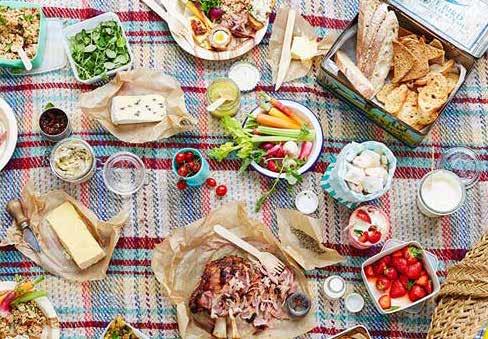

THE GREAT BRITISH PICNIC MENU

Potato Salad
Although hailing from Germany, potato salad is a popular addition to any British picnic. There are many delicious variations to this traditional recipe, but here is a simple way to produce a potato salad that is regularly gobbled up across Britain.
Ingredients (serves 4):
400g (2 2/3 cups) white potatoes (peeled or with skins left on, as preferred) 2-3 tablespoons mayonnaise 1 teaspoon chopped dill or chives 1 tablespoon of chopped spring onion 1 teaspoon ground black pepper 1 boiled egg 1 tablespoon chopped fresh parsley 1 teaspoon mustard (preferably Dijon) Pinch of salt
Preparation:
Start by chopping the potatoes into bite-size chunks and boil in a saucepan of seasoned water. Once soft, drain and put back into the saucepan to steam for a few minutes. Slice the boiled egg into small pieces and add to the steaming potatoes. Next add the mayonnaise, chopped fresh herbs, mustard and salt. Carefully stir until combined. Transfer the potato salad into a bowl and leave to chill in the fridge for 30 minutes – after this the salad is ready for the picnic basket!
Fairy Cakes
Those who have visited the perpetually pink Peggy Porschen in west London know how seriously cupcakes are taken in Britain. Although originating in America, fairy cakes (as they are often called) are a dainty and delicious addition to any outdoor feast. Why not go full Anglophile and add blue and red food colouring to your frosting mix to create a Union Jack themed sweet treat?
Ingredients (makes 12):
Buttercream 150g (2/3 cup) butter 1 teaspoon of vanilla extract 300g (3 cups) icing sugar 2-3 tablespoons of milk 1 or 2 drops of food colouring, depending on the desired effect Cake mix 110g (1/2 cup) butter 110g (1/2 cup) caster sugar 110g self-raising flour (1 cup) - this can also work with plain flour by adding a teaspoon of baking soda 2 eggs 1 teaspoon of vanilla extract Pinch of salt
Preparation:
Preheat the oven to 180°C (356°F, Gas Mark 4), and place 12 paper cupcake cases on a baking tray. Grab a large mixing bowl and use a hand whisk or electric mixer to combine the butter and sugar until fluffy. Next, slowly add the eggs and vanilla extract, mixing for a few minutes more. Add the salt and continue to gradually add the flour into the mix, stirring continuously. Once the ingredients are fully mixed, carefully spoon into the cases and place into the oven. They will only take 15 minutes to turn golden brown, but use the skewer test to make sure they are fully baked through – a clear skewer poked in the middle of a cake means they are done. While the cakes bake, make a start on the buttercream frosting. Start by mixing the room temperature butter with a hand mixer or wooden spoon until fluffy. Sieve the icing sugar into the butter and add the vanilla extract. Once mixed, add the milk and continue to beat for a few more minutes. Separate the mix into three and stir in the food colouring to create the red, white and blue colour scheme.

Flapjacks
Golden brown and brimming with golden syrup, the oat flapjack is a picnic pudding loved throughout the nation. The word flapjack has been used in Britain since the 16th century, with Shakespeare himself mentioning ‘flap-jacks’ in Pericles, Prince of Tyre, as reference to a common English pudding. However, the dish we know and love today was not created until 1935.
Ingredients (serves 6):
600g (6 cups) porridge oats 300g (1 1/3 cups) butter or margarine 250g ( just under 3/4 of a cup) Golden Syrup 200g (1 cup) caster sugar Handful of sultanas (optional) 2 teaspoons of cinnamon
Preparation:
Line a baking tray with butter or greaseproof paper and pre-heat the oven to 180°C (356°F, Gas Mark 4). Pour the sugar, syrup and butter into a saucepan and heat slowly, stirring until they are melted and combined. Take the pan off the heat and add the oats, cinnamon and sultanas, mixing until the ingredients have bound together. Spread onto the baking tray and pat down. Bake for 25 minutes or until golden brown. Remove from the oven and cut into equal pieces while hot, leaving to cool before enjoying.
Pimm’s
Royal warrant holder and drinks maker, Pimm’s is a British liqueur that sparks fond memories of summer fun for many Brits. Made from a secret gin recipe infused with caramelised orange, warming spices and herbal botanicals, this drink is best served with a refreshing mixer, a selection of sliced fruits, ice and mint leaves.
It is particularly popular as a refreshment at Wimbledon tournaments, summer parties, and of course, British picnics!
Ingredients (all to taste):
Pimm’s No. 1. (similar drinks are also available, such as Austin’s, Jeeves and Pitchers) Ginger ale or lemonade Cucumber slices Lemon slices Orange slices Strawberries (halved) Sprig of mint
Preparation:
Place a few ice cubes in a glass and pour one part Pimm’s to two or three parts ginger ale/lemonade, depending on the desired strength. Add a slice of cucumber, lemon, orange and strawberries, as well as mint leaves. Gently stir the cocktail and enjoy! This recipe can also be used in bigger portions to create a sharing pitcher.
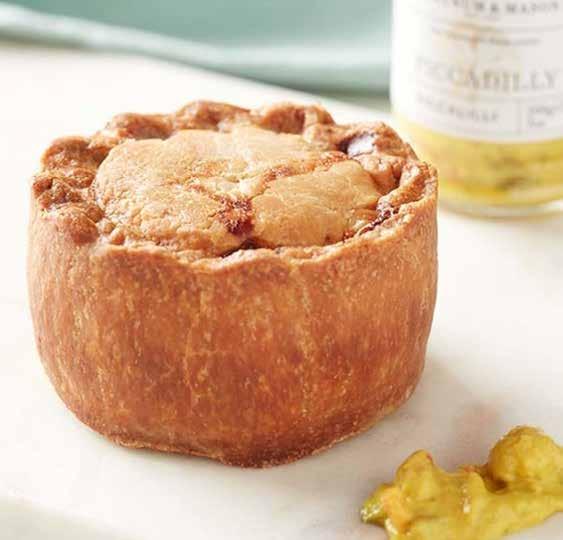
Pork Pies
Pork pies have been eaten in Britain since medieval times, when their thick pastry crusts were simply used as a way to preserve their meaty fillings. The confection itself has seen many variations over the centuries, from meat and fruit combinations to adding half a pint of white wine into the mix. Today, it takes the form of a classic high crusted pie, with the meat surrounded by a layer of jelly to help it retain its moisture.
Having used the same traditional pork pie recipe since 1851, Ye Olde Pork Pie Shoppe in Molton Mowbray, Leicestershire, is the home of the pork pie, a taste that foodies can attempt to replicate for their very own British picnic…
Ingredients (makes 4 pies)
For the pastry 3 tablespoons milk 40g (2/5 cup) lard 40g (2/5 cup) butter 340g (1 cup) plain flour 1/2 teaspoon salt
For the filling
500g ( just over 2 cups) pork shoulder, cut into 1cm cubes 120g (1/2 cup) pork sausage meat 180g (3/4 cup) chopped bacon Pinch of nutmeg Pinch of salt 1/2 tablespoon finely chopped fresh or dried sage 1/2 tsp ground black pepper 1 beaten egg 150ml (2/3 cup) chicken stock 3 sheets of gelatine
Preparation:
Start by creating the pastry. Put 110ml (1/2 cup) water in a small saucepan, add the milk, lard and butter and slowly heat until the hard ingredients have melted, then turn up the heat and bring to a boil. Using a sieve, mix the flour and salt together in a large mixing bowl and carefully add the just-boiled wet ingredients. Mix until it forms a dough, kneading lightly with your hands until the dough is smooth. Wrap tightly in cling film and set aside to rest at room temperature for 20 minutes. Thoroughly combine the meat, nutmeg, sage, and black pepper in a mixing bowl with a large pinch of salt. Next, cut away 1/3 of the dough and separately wrap it in cling film, before dividing what is left into equal pieces. Grab four average sized jars and wrap the bases in cling film. Divide the remaining pastry into four even pieces, mould each one carefully around the base of the jar, until it reaches about nine centimetres from the base. Cover each of the jars evenly, mindful to not to make the base too heavy. Once all four are covered place upside in the fridge for one hour. Whilst waiting for the four pie bases to chill and turn hard, divide the remaining pastry into four equal parts. Roll each of them to create a circle around eight centimetres in diameter, these can then be covered with cling film and left at room temperate until needed. Preheat the oven to 180°C (356°F, Gas Mark 4) and carefully remove the now chilled pastry bases from their refrigerated jar moulds by pouring boiling water into each jar. Once loosened they can then be gently pulled off and placed on a baking tray. Spoon the pork filling into each of the cases. Now add the pastry circles on top of the filled pies and secure them by pinching the edges together by hand. Brush the pies with beaten egg and use a skewer or thin knife to make a small hole in the top of each. Cook for 50 minutes, until completely golden brown. Heat the stock until almost boiling before removing from the heat. Soak the gelatine sheets in cold water for five minutes to soften. Squeeze the sheets to remove any extra water then add the gelatine to the hot stock, stirring occasionally. To add the distinctive jelly to these savoury creations, carefully funnel the stock through the holes at the top. This can be done with a small funnel or piping nozzle, making sure to allow time for the mixture to fill the gaps between the filling and the pastry without flooding. Once full, leave to cool and then chill the pies for a minimum of four hours so that the jelly has time to set.
For more information contact the Visit Britain Media Team on: pressandpr@visitbritain.org
Keeping your static home safe in winds and storms
In the early 1900s, the gentry could have a horse-drawn caravan built that was transported by train to a summer plot where it remained static. By 1947, the first static caravans (as we know them) started to
Stats appear. from the
National Caravan Council reveal that in the UK, it is estimated that there are a whopping 365,000 caravan holiday homes in use! 43% of people said they’d pay more to stay in a caravan holiday home with underfloor heating or a hot tub.
After a much-delayed start to the caravanning season, the number of holidays this year have probably not turned out as you might have wanted – and now it’s already time to start thinking of battening down the hatches of your static caravan for the winter months ahead.
One of your main concerns now, therefore, may be ways of keeping your holiday home safe in winds and storms.
What can go wrong?
The relatively lightweight construction of your static caravan and the often open and exposed campsites on which they are pitched, leaves these holiday homes especially vulnerable to high winds and storms.
For a sense of perspective on the amount of damage that might be caused the ITV reported on flooding caused by Storm Ciara earlier this year where guests had to be evacuated. You can also watch a short video broadcast by the BBC showing a static caravan being swept downstream as a result of the same storm. It is frightening stuff!
Siting and anchoring your static caravan
The National Association of Caravan Owners (NACO) explains that the precise siting and orientation of your static caravan is the responsibility of the site owners. For that purpose, best practice is set out in guidelines on the “transportation, siting and commissioning of caravan holiday homes”. Although you should not alter the way in which your caravan is sited, you can do more to give it greater stability in high winds and storms by anchoring it to the ground. Indeed, some sites insist that you anchor the caravan to the base or hard standing on which it is situated. Anchor points are typically found roughly one meter from the front and rear of your holiday home on the main lengthways chassis members.
Battening down the hatches
As winter – along with its wind and storms – approaches, it is worth spending some time making sure that your holiday home is as prepared as possible for any onslaught:
make sure to take down and put into storage any awnings, of course – they are likely to be the first to be ripped from their fastenings and blown away in a high wind; make sure any skylights are firmly closed to make a good seal; secure all doors and windows, so that if the wind comes a-rattling, they are not damaged by the excessive movement;
check the fixings of all rainwater goods such as gutters and downpipes, re-securing them where necessary; and check the fastenings of any aerials – or even consider removing them during the winter months, when you are unlikely to be using your static caravan anyway. Don’t also forget to make sure that garden furniture, gas bottles etc. are all safely locked away to avoid them being picked up by the wind and damaging someone else’s static home. A thorough check now may help to ensure that neither your caravan nor anything attached to it gets blown away during the autumn and winter’s strong winds and storms.
TAKE A ROAD TRIP THROUGH BRITAIN
Escape Britain's motorways and visitors are often amazed at what they discover. From mountain passes to scenic coastal drives, Britain has plenty of stunning driving routes that are ideal to build a driving holiday around. Words and images courtesy of VisitBritain.com.
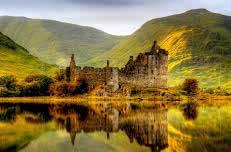

1. A82 - Loch Lomond to Loch Ness
This scenic route is widely regarded as one of the most iconic in Britain. Starting in Glasgow, the A82 stretches north into the Scottish Highlands, passing Loch Lomond before heading into arguably the highlight of the route – Glencoe. This stunning area has been called the most spectacular location in Britain, and one look makes it easy to see why. Film buffs will also recognise the area from the James Bond film, Skyfall. After Glencoe, the A82 rounds Loch Leven before passing through Fort William. On this stretch of road, drivers are able to spot Britain’s tallest mountain Ben Nevis towering above them. Those feeling particularly adventurous often stop in Fort William and attempt to climb the mountain’s peak. Continue north on the A82, and encounter another iconic British location – Loch Ness. Drive alongside the Loch and try to spot the legendary Loch Ness Monster, or stop off and take a relaxing walk around the area to finish the road trip in style. The ruins of Urquhart Castle date back to the medieval period and stand proudly overlooking Loch Ness too. Trace 1,000 years of history while taking in the remarkable nature that surrounds this majestic landmark. The 140-mile route can be completed in around threeand-a-half hours, but it’s worth stopping off at numerous locations along the way to take in the sights!
2. A3055 - Military Road (Isle of Wight)
Running parallel with the west coast of the Isle, the A3055 (aka Military Road) is a road trip that should be taken sooner rather than later, as erosion along the coast could see parts of the road disappear! Landslides have reduced some sections of the road to single file traffic and marker boards along the route will illuminate to shut it immediately in the event of another landslide. The A3055 dates backs to the mid-18th century when it formed a key part of the island’s military infrastructure. Linking St Catherine’s Point, near Chale, with Freshwater Bay to the west, the 11-mile route may be short, but it offers a wealth of sweeping ocean views and memorable country landscapes. No stopping is allowed on the section of road between Brook and Freshwater Bay as it is a designated Clearway, but there are a number of official car parking areas where travellers can stop to enjoy the views.
3. B3135 - Cheddar to Ashwick
Cutting a route through the Mendip Hills, designated an Area of Outstanding Natural Beauty, the B3135 twists its way through cliffs and a gorge in central Somerset. Primarily known for its cheese, the village of Cheddar is also surrounded by lush, scenic country routes. Adventurous drivers can look forward to navigating the tight, winding bends through the spectacular Cheddar Gorge, before sweeping turns lead to the quiet village of Ashwick.
Despite not being the longest drive - around 14 miles - the stunning surroundings make for an unforgettable trip to England’s West Country. There’s plenty of other attractions in the area too, but none offer a sense of adventure quite like a drive through Cheddar Gorge. Set aside around 30 minutes to complete the route.
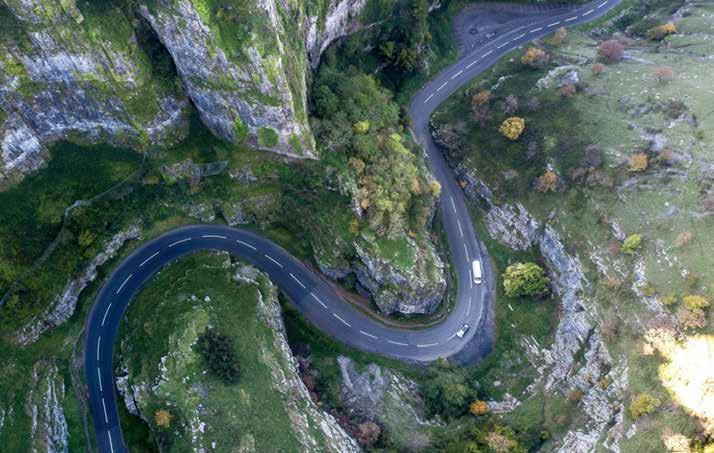

4. Wrynose and Hardknott Pass
For those dreaming of a road-trip challenge, Wrynose and Hardknott Pass is ready and waiting. Featuring some of the steepest roads in Britain (Hardknott Pass has a 33% gradient at one point), this route is not for the faint-hearted. However, those who do brave the route one day will be treated with spectacular views across the Lake District, along with one hell of a story to tell when they head home. The single track route has plenty of twists and turns between the picturesque village of Eskdale and the town of Ambleside. It also passes the Hard Knott Fort, once one of the loneliest outposts of the Roman Empire. Built between 120 and 138AD, the archaeological site overlooks the pass which forms part of the Roman road linking Ravenglass to Ambleside, and Brougham to Penrith.

Images courtesy of VisitBritain.com
TAKE A ROAD TRIP THROUGH BRITAIN
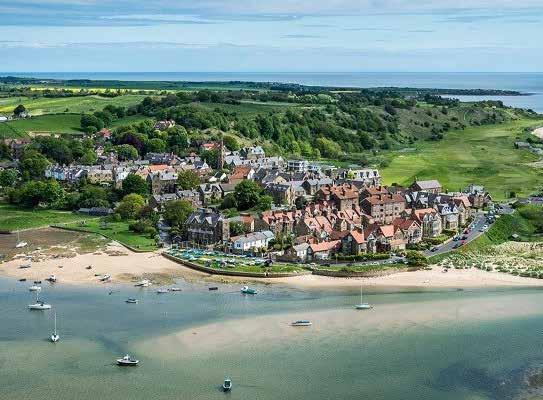

5. Evo Triangle
Named after Evo magazine which often uses this route to test or review new cars, the Evo Triangle combines three roads in North Wales. Starting on the A5 near Cerrigydrudion, head west towards the quiet village of Pentrefoelas, before taking a right turn onto the A543, where the Evo Triangle really starts to shine.
Tight bends and sweeping vistas make the uphill climb a joy, with the road veering off ahead almost endlessly. Eventually, the route will pass the Sportsman’s Arms, before taking a right onto the B4501. This is arguably the finest stretch of the route, featuring panoramic views across the Alwen Reservoir and a twisting, turning road that supplies plenty of thrills. At just over 20 miles, the route takes around 30 minutes to complete, and drivers might even see the latest sports cars being tested!
6. Alnmouth to Lindisfarne
Driving through the countryside can sometimes be a chore, but not on the Northumberland Coast. This route from Alnmouth to Lindisfarne Nature Reserve follows the coast, offering spectacular views across the North Sea. The Northumberland Coast is also littered with castles, towering above the roads on hillsides; Bamburgh Castle is a particular highlight on this route. Originally the site of a Celtic fort, the imposing stone castle was built in the 12th century and its walls have witnessed dark tales of rebellion and bloodshed. At the end of the journey lies Lindisfarne, an Area of Outstanding Natural Beauty and a historic gem in northern England. The sight of the first Viking invasion in 793AD, Holy Island and Lindisfarne Castle are both picturesque from afar. Those who intend to get closer, beware; the causeway leading to Holy Island becomes unusable at certain points because of tidal shifts! Expect to spend around an hour driving the route, although there are numerous opportunities to stop and admire the scenery along the way. 7. Bealach na Ba
Historically used to drive livestock across the mountains, Bealach na Ba (aka Pass of the Cattle in English) has been transformed into one of the most scenic drives in Britain. It’s a little intimidating at first, but any worries will all melt away near the midpoint, thanks to glorious views across the Scottish Highlands. The winding single-track road dates back to 1822 and was engineered in a similar vein to the great mountain routes in Alpine Europe. There’s no complex directions to follow on this one; just follow the road south of Tornapress towards Applecross, before ascending across the Bealach na Ba. There’s plenty of stopping points along the 11-mile route, so make sure to get out and take time to enjoy the view! 8. A470 - Brecon Beacons to Snowdonia
The A470 runs across most of Wales, linking Cardiff in the south with Llandudno in the north, and if drivers venture northwards on the road, they’ll be able to see some of the best views that the country has to offer. North of Merthyr Tydfil, the A470 enters the Brecon Beacons National Park, with its rolling hills and near endless horizon.
Continue onwards and the A470 heads into the Welsh countryside, passing through numerous tiny villages and communities. There’s plenty of opportunity to break off and explore the surroundings, but stick with the A470 to eventually arrive in Snowdonia. Along the way, drivers will find themselves surrounded by mountains in the distance and views that just keep getting better. A mix of single carriageway roads and sweeping dual carriageways, the 178-mile route can be completed in around four-and-a-half hours. The Cambrian Way, a journey across the mountainous spine of Wales, follows much of the A470, with additional detours to sites including Welsh Royal Crystal at Rhayader and Adventure Parc Snowdonia. 9. Snake Pass

Located in the Peak District, Snake Pass provides a route across the Pennines between the market town of Glossop and Sheffield. As one might expect from the name, Snake Pass is full of curves and bends, with each one offering a glorious view of its own. In the late summer, heather blooms across the surrounding hills, bathing the area in a gorgeous purple colour – it’s a spectacular sight. Once the main route linking Sheffield to Manchester when it opened in 1821, Snake Pass experiences regular snowfall in the winter months and is often closed during these periods. It’s popular with bikers and cyclists during the rest of the year, with a leisurely drive along the 20-mile route taking in the region of 30 minutes. 10. B3306 - St Ives to St Just
The B3306 might not be the quickest route between St Ives and St Just, but it’s definitely the most exciting. A 13-mile stretch of coastal road, the B3306 twists and turns between quaint villages and hills sloping down to the ocean. The B3306 follows the ‘Tin Coast’ of the Penwith peninsula and near Trewellard is the Levant Mine and Beam Engine, part of the Cornish Mining World Heritage Site, which is home to numerous surviving mine buildings and a restored 1840s engine. Or venture to Pendeen, to see the Geevor Tin Mine, a well-preserved museum that stands as it was left by the miners in 1990.
For more information contact the Visit Britain Media Team on: pressandpr@visitbritain.org
